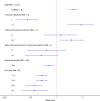Effects of infection history on dengue virus infection and pathogenicity
- PMID: 30886145
- PMCID: PMC6423047
- DOI: 10.1038/s41467-019-09193-y
Effects of infection history on dengue virus infection and pathogenicity
Abstract
The understanding of immunological interactions among the four dengue virus (DENV) serotypes and their epidemiological implications is often hampered by the lack of individual-level infection history. Using a statistical framework that infers full infection history, we analyze a prospective pediatric cohort in Nicaragua to characterize how infection history modulates the risks of DENV infection and subsequent clinical disease. After controlling for age, one prior infection is associated with 54% lower, while two or more are associated with 91% higher, risk of a new infection, compared to DENV-naive children. Children >8 years old have 55% and 120% higher risks of infection and subsequent disease, respectively, than their younger peers. Among children with ≥1 prior infection, intermediate antibody titers increase, whereas high titers lower, the risk of subsequent infection, compared with undetectable titers. Such complex dependency needs to be considered in the design of dengue vaccines and vaccination strategies.
Conflict of interest statement
The authors declare no competing interests.
Figures




Similar articles
-
Symptomatic versus inapparent outcome in repeat dengue virus infections is influenced by the time interval between infections and study year.PLoS Negl Trop Dis. 2013 Aug 8;7(8):e2357. doi: 10.1371/journal.pntd.0002357. eCollection 2013. PLoS Negl Trop Dis. 2013. PMID: 23951377 Free PMC article.
-
Antibody Epitopes Identified in Critical Regions of Dengue Virus Nonstructural 1 Protein in Mouse Vaccination and Natural Human Infections.J Immunol. 2017 May 15;198(10):4025-4035. doi: 10.4049/jimmunol.1700029. Epub 2017 Apr 5. J Immunol. 2017. PMID: 28381638 Free PMC article.
-
Complexity of Neutralizing Antibodies against Multiple Dengue Virus Serotypes after Heterotypic Immunization and Secondary Infection Revealed by In-Depth Analysis of Cross-Reactive Antibodies.J Virol. 2015 Jul;89(14):7348-62. doi: 10.1128/JVI.00273-15. J Virol. 2015. PMID: 25972550 Free PMC article. Clinical Trial.
-
Neutralizing antibody titers against dengue virus correlate with protection from symptomatic infection in a longitudinal cohort.Proc Natl Acad Sci U S A. 2016 Jan 19;113(3):728-33. doi: 10.1073/pnas.1522136113. Epub 2016 Jan 4. Proc Natl Acad Sci U S A. 2016. PMID: 26729879 Free PMC article.
-
Modulation of Dengue/Zika Virus Pathogenicity by Antibody-Dependent Enhancement and Strategies to Protect Against Enhancement in Zika Virus Infection.Front Immunol. 2018 Apr 23;9:597. doi: 10.3389/fimmu.2018.00597. eCollection 2018. Front Immunol. 2018. PMID: 29740424 Free PMC article. Review.
Cited by
-
Genetic Analysis of Dengue Virus in Severe and Non-Severe Cases in Dhaka, Bangladesh, in 2018-2022.Viruses. 2023 May 10;15(5):1144. doi: 10.3390/v15051144. Viruses. 2023. PMID: 37243230 Free PMC article.
-
A murine model of dengue virus infection in suckling C57BL/6 and BALB/c mice.Animal Model Exp Med. 2020 Dec 21;4(1):16-26. doi: 10.1002/ame2.12145. eCollection 2021 Mar. Animal Model Exp Med. 2020. PMID: 33738433 Free PMC article.
-
Reemergence of dengue virus in Bangladesh: Current fatality and the required knowledge.Tzu Chi Med J. 2019 Oct 17;32(3):227-233. doi: 10.4103/tcmj.tcmj_193_19. eCollection 2020 Jul-Sep. Tzu Chi Med J. 2019. PMID: 32955510 Free PMC article. Review.
-
Serodynamics: A primer and synthetic review of methods for epidemiological inference using serological data.Epidemics. 2024 Dec;49:100806. doi: 10.1016/j.epidem.2024.100806. Epub 2024 Nov 30. Epidemics. 2024. PMID: 39647462 Free PMC article. Review.
-
Primary exposure to Zika virus increases risk of symptomatic dengue virus infection with serotypes 2, 3, and 4 but not serotype 1.medRxiv [Preprint]. 2023 Nov 30:2023.11.29.23299187. doi: 10.1101/2023.11.29.23299187. medRxiv. 2023. Update in: Sci Transl Med. 2024 May 29;16(749):eadn2199. doi: 10.1126/scitranslmed.adn2199. PMID: 38077039 Free PMC article. Updated. Preprint.

